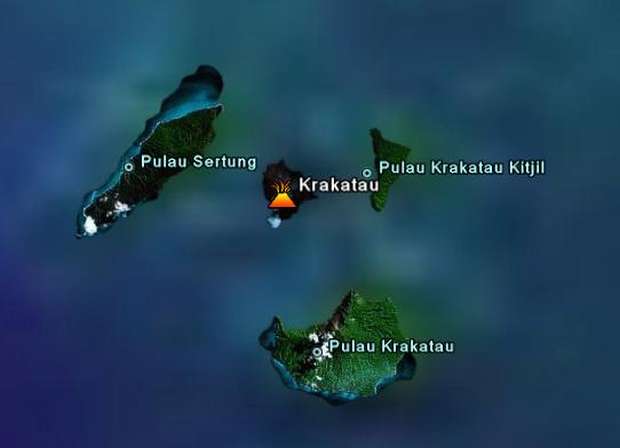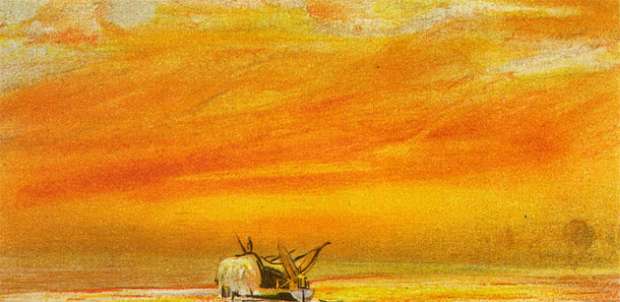The obliteration of the island of Krakatoa by a volcano, thought by many to be extinct, may have been the result of the loudest explosion ever. Its aftermath, a giant tidal wave, wreaked further devastation and killed tens of thousands of people.
The eruption of the island of Krakatoa on 27th August 1883 has been called the greatest explosion in history. It destroyed 300 villages and killed 30,000 people: houses were cracked open 100 miles (160km) away; the volcano’s roar was heard over distances of 3000 miles (4800km); the shock wave in the air blasted around the globe seven times; and bodies and wreckage floated in the sea for days afterwards.
At the beginning of 1883 Krakatoa (or Krakatau) seemed an ordinary volcanic island lying in the Sunda Strait between Java and Sumatra in the Dutch East Indies (present-day Indonesia). Few islanders worried about the 2700ft (820m) peak that dominated the skyline: there had been no sign of activity since a recorded eruption in 1680 and some assumed that the volcano was extinct. But on 20th May 1883 the mountain’s cone burst into life, venting steam and hurling hot ash high into the sky. This initial explosion soon died down, and further eruptions as the summer advanced were also minor. Still few local people worried such tremors were common in the islands. By August, however, loud groans were heard coming from deep under the ground.

At 1 pm on 26th August a deafening explosion shook the island. One hour later, a vast cloud of black ash 17 miles (27km) thick hung in the air. Many islanders took to the sea. An Englishman who escaped the devastation in this way recorded: “The poor natives, thinking that the end of the world had come, flocked together like sheep, and made the scene more dismal with their cries”.
The climax came the next day when a violent upheaval ripped the island apart. Two-thirds of Krakatoa simply ceased to exist. More than 4 cu miles (19km) of rock were pulverized into dust and hurled 35 miles (55km) into the air. Before long an area 180 miles (280km) wide was plunged into total darkness. The noise of the explosion temporarily deafened the citizens of northern Java, some 100 miles (160km) away and the inhabitants of the Indian Ocean island of Rodriguez, 3000 miles (4800km) to the west, imagined that a great naval battle was aking place just beyond the horizon.
A giant crater, 4 miles (6km) across and some 900ft (275m) under water, was all that remained of the island. As the crater filled with seawater It set off a massive tidal wave, 120ft (40m) high, that surged out from the island at the rate of 700mph (1100 km/h) – almost the speed of sound. The great wall of water destroyed neighboring islands, flooded coastlines and was felt as far away as Hawaii and southern California. By 28th August all was quiet, although minor tremors and eruptions continued until February 1884.
The explosion had dramatic consequences. In the seas around Java and Sumatra, rafts of pumice – ejected by the volcanic cone – hampered shipping for several days and for months afterwards blocks of this material floated around the Indian Ocean. Volcanic dust remained in the atmosphere for more than a year, creating spectacular sunsets around the globe and haloes around the sun. the dust also made the sun and moon appear green or blue on occasions and, it seems, reduced temperatures below their normal levels.

The early stages of the eruption were photographed and engravings were made showing Krakatoa as it once was – remote and covered with lush, tropical vegetation. When the volcano was again quiet, all life on the remains of the island was covered in a thick ash. Five years elapsed before Krakatoa’s plants and animals began to re-establish themselves.
Volcanic activity is always intense where tectonic plates collide. At least 100 volcanoes – including Krakatoa – are situated along the line where the Indo-Australian plate meets the Eurasian plate in Java and Sumatra. Fresh upheavals in December 1927 produced of the beginnings of a new island beneath the surface of the sea. After the 1883 eruption, all that remained of the island of Krakatoa were small, jagged islets. A massive explosion 25 years later thrust this underwater landmass upwards to form a small island, Anak Krakatau. By the end of the twentieth century the island stood 670ft (200m) above sea level and measured more than 1 mile (2km) across. Inevitably his ‘son of Krakatoa’ will at some time in the future face the same face as its parent.



































